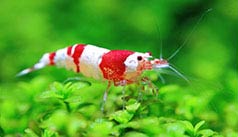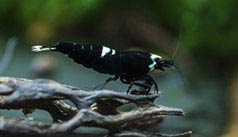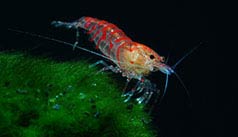

Alternative species (click on the thumbnail to see the card)
Names
Scientific name
Caridina cantonensis sp Pinto
Common name
Pinto shrimp
Origin

Origin: Southern China
Biotope: Asian
Dimorphism

The female is larger, with a wider abdomen. Its antennules are smaller than those of the male
Group

Atyidae
Volume

25 L / 5 imp gal / 7 US gal
Parameters

T°: 20 to 23°C or 68 to 73°F
pH: 6.2 to 6.5
GH: 5°dGH - KH: 0
Difficulty
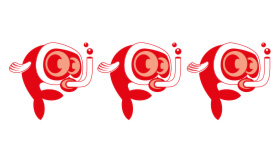
Hard
Size
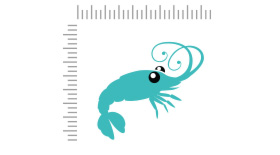
1 to 3 cm (0.4 to 1.2")
Longevity
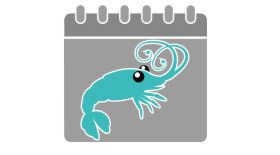
2 years
Living zone
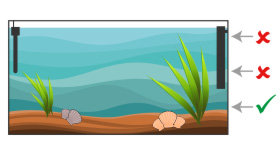
Depth
Individuals
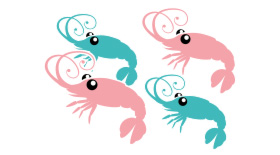
10
Food
How to feed the Pinto shrimp?
Food
How to feed the Pinto shrimp?
This is one of the first key points for the proper maintenance of these shrimps. In fact, overeating is deadly because it contributes to polluting the water (rise of nitrates NO3). First of all, rest assured, shrimp rarely die of starvation. Indeed, they always find something to eat in a mature aquarium: algae and micro-foods. So if your aquarium has been in water for at least 3/4 months, this is a first small stock of interesting food.
Most of the food will be tree leaves. Choose oak, chestnut, hazel or beech leaves. To prevent disease, you can "cook" 30 seconds in the microwave and leave them in a container of water (the same water as that of the aquarium) enough time so that they are impregnated. When they finally sink, you can put them at the bottom of your shrimp's aquarium. The Caradina cantonensis pinto will feast on these leaves, which also do not pollute the water and remind them of their natural environment. Watch for the condition of these leaves to remove them from the aquarium before they rot.
Vary this natural food with different foods. For this, you can for example give a background tablet containing spirulina (or a half depending on the number of shrimp in the aquarium). Attention, this kind of food is to be distributed only once a week.
Also offer poached vegetables such as zucchini, cucumber, broccoli or spinach. Bananas or raw carrots will also work very well. Finally, shrimps love dried nettle leaves! Remember to remove the non-consumed foods quickly so as not to pollute the water in the tank.
The golden rule: feed little, but often!
Behavior
What kind of behavior does the Pinto shrimp have?
Behavior
What kind of behavior does the Pinto shrimp have?
All Pinto are peaceful. They like to live in groups of at least 10 individuals.
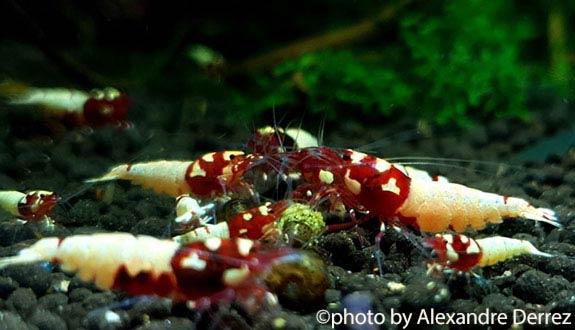
Shrimps like to live in a group!
Most of their time is spent digging the ground and elements of the scenery for food.
Cohabitation
Who can live with the Pinto shrimp?
Cohabitation
Who can live with the Pinto shrimp?
Like many invertebrates, these shrimps are the natural prey of fish. In addition, the particular water parameters required by Caradina cantonensis pinto greatly limit the possibilities.
The ideal roommates are the other shrimp, but you should be careful about hybridization (see "Good to know") except in cases where this is controlled and desirable.
With fishes, cohabitation with Ancistrus, Corydoras or Otocinclus does not pose a problem of predation (but beware of the compatibility of the parameters of your aquarium and its volume).
Breeding
How to breed the Pinto shrimp?
Breeding
How to breed the Pinto shrimp?
The breeding is spontaneous from the moment when the two sexes are put in presence and that the conditions of maintenance are scrupulously respected (in particular the temperature, a minimum of 22/23°C or 71/73°F is essential). The small shrimps do not require passage in brackish water, which removes a lot of difficulty.
Pintos are not as prolific as Neocaridinas (Red cherry). Thus, they will give birth to only thirty small maximum per litter.
Once the mating is over, the eggs are transferred under the belly of the female, which will keep them for 20 to 25 days (you can then see it air its eggs regularly). When the eggs hatch, the young shrimp are already fully formed and are fully autonomous.
Its aquarium
Which aquarium for the Pinto shrimp?
Its aquarium
Which aquarium for the Pinto shrimp?

Pinto shrimp will spend most of their time digging the substrate. They will need space! So, it's not really the volume that counts, but the space on the ground. To optimize their living space, choose a rectangular aquarium spacious enough but not necessarily very high.
A second key element (after that of food, see "food") for the proper maintenance of these shrimps is the use of a technical floor (or also called "active soil"). This type of soil aims to reduce the carbonate hardness (KH) to a value close to 0. It will also participate in the reduction of the total hardness (GH). A number of these technical soils have already been proven, such as Florabase, Amazonia, Malaya Aqua Soil, Akadama, Egi Gold, Red Bee Sand or Oliver Knott for example. Finally, note that it is useless, even harmful, to clean this type of soil too often.
To keep the properties of the technical floor as long as possible, it is recommended to use only remineralized osmosis water in the aquariums that have them. For this, you will use osmosis water to which you add salt Preis Discus until you get the desired hardness. Ideally, you will seek to obtain a conductivity of 300μS (count about 1,37g of Salt for 5 liters of osmosis water). With this method, you increase the GH without touching the KH. Finally, note that some aquarists use pure osmosis water.
Choose a good filtration that will ensure a good quality of water, and protect the suction strainer to prevent the young shrimp are sucked up and remain trapped in the filter.
As for decoration, you're pretty free. The only rule is that Pinto shrimps like very planted aquariums, especially mosses (Riccia, Java moss, Fissidens fontanus for example). Also put some floating plants to sift the lighting. Finally, finish your decoration with roots or rocks (not especially limestone). In fact, these elements contribute to the feeling of safety of shrimps, which are then less subject to stress.
Finally, finish the layout of your shrimp tray by strewing the soil with tree leaves. These leaves will serve as food (see "food") and will give a more natural look. In addition, these leaves will help lower and stabilize the pH. You can use hazel, chestnut, oak or beech leaves.
The maintenance of the water is to be carried out gently and cautiously as the Pinto are very sensitive to changes in the water parameters. In addition, shrimp are much less polluting than fish: you can space water changes or make less important. The best method is to check when to change the water. For this, make tests of nitrites (NO2) and nitrates (NO3) every week. If the values revealed are too important, make a change of 10 to 20% of the water and then repeat the control, and so on until the desired value. However, be aware that it will generally be necessary to change water by up to 10% weekly.
Remember to put a lid on your aquarium to limit evaporation. If you wish to complete the level to compensate for evaporation, it is essential to use only PURE reverse osmosis water (without Preis salt) in order not to vary the water parameters.
Good To know
Find all additional information!
Good To know
Find all additional information!
Caradina cantonensis pinto are derived from selection and breeding of Taiwan Bee.
Hybridizations are possible with other Caradina Cantonensis.
These shrimps are very sensitive to heavy metals such as copper for example. It will therefore be necessary to wash the new plants before putting them in the water of the tank. Similarly, the use of fertilizers and medicines should be avoided. In case of extreme necessity, refer to the precautions for use in the operating instructions.
Caridina Cantonensis Pinto Red

Caridina Cantonensis Pinto Black
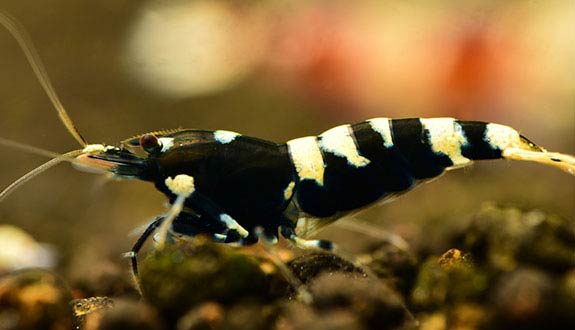
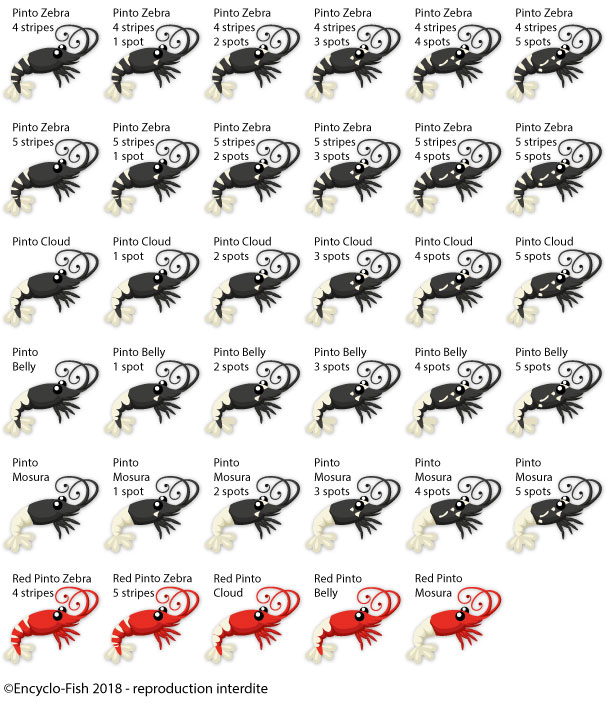
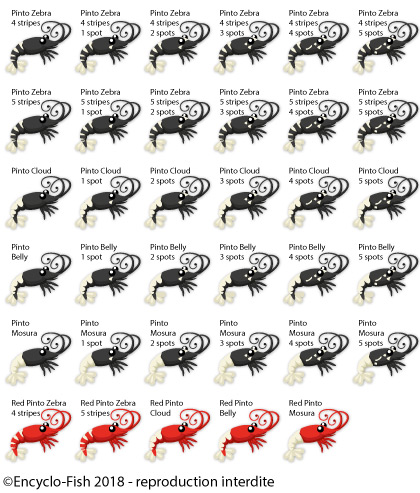
Yours photos!
Comments
Sort by:
Please login to post comments
